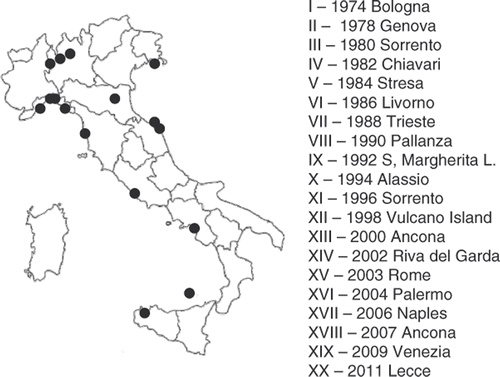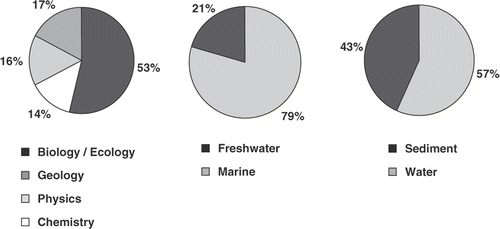Abstract
On the occasion of the 35th year from the publication of the first issue of the Proceedings of the Italian Association of Limnology and Oceanography (AIOL) we present here the results of a meta-analysis of all of the material included in the AIOL Proceedings, with the aim of analysing the last 30 years history of aquatic science in Italy as mirrored by the science presented by the AIOL members. The results of this meta-analysis were presented in September 2006 in Paris, on the occasion of the 100th anniversary of the ‘Institut océanographique, fondation Albert Ier, prince de Monaco’. We have screened the 17 volumes of the Proceedings and classified the articles into papers dealing with: (i) Biology and Ecology; (ii) Chemistry; (iii) Physics, and (iv) Geology, which represent the most relevant ‘disciplines’ of the AIOL. The articles were also classified as ‘oceanographic’ or ‘limnological’ papers, including all marine and freshwater aspects, respectively. Articles were finally classified on the basis of the environment where the studies were carried out: the water column or the benthic environment. The results of this analysis highlight the presence of wide fluctuations in the number of publications produced by the AIOL scientific community during more then three decades of the activity of the association in Italy. We also show that these fluctuations were associated with variable fluctuations in the availability of funding for aquatic research. The overall picture of the scientific outputs of the AIOL members as revealed by the analysis of the papers published on the AIOL Proceedings indicates that the Association had a fruitful activity during the last part of the past century, but experienced a major flaw during the first years of this century. Only in the last few years such activity restarted, thus giving rise to a possible new deal in the development of aquatic science in Italy.
1. A brief overview of the association and its structure
The Italian Association of Limnology and Oceanography (hereafter AIOL) was founded on 27 June 1972 by seven pioneers with different expertise in aquatic science: G. Macchi (chemist), C. Morelli (geologist), R. Selli (geologist), N. Della Croce (oceanographer), L. Tomadin (geologist), L. Tonolli (limnologist) and A. Macchiavelli (oceanographer). Since its foundation, the institutional aims of the AIOL are promoting and stimulating the collaboration between Italian oceanographers and limnologists, two categories of scientists formally divided by the salinity of their study sites but facing similar physical, chemical and ecological processes.
The AIOL was founded in order to build up a cultural bridge towards the creation of an ‘aquatic science community’ as wide as possible and covering biology and ecology, physics, chemistry, geology and–ideally–all of the disciplines related with the ‘aquatic sciences’. In this sense, the creation of the AIOL, linking together marine and limnological researchers, merged two ‘aquatic souls’. While the Italian Association of Marine Biology hosts most of the marine biologists community, the AIOL includes a multifaceted community of scientists spanning from physical, chemical and geological oceanographers as well as the wide and productive ‘freshwaters’ community.
Since its foundation, the AIOL has been formally leaded by a President in charge for a maximum of two consecutive mandates lasting two years each. The President is helped by a Presidency Council made of six elective members and including a general secretary, a treasurer and the Editor of the AIOL Proceedings, nominated by the Presidency Council. The activities of the Presidency Council are also open to the AIOL delegates to the European Federation of Marine Science and Technology Societies (EFMS) and to the European Federation for Freshwater Scientists (EFFS).
Since 1972 the AIOL has been leaded by 12 Presidents (), all being re-known experts in their field of expertise. The most important official documents produced by the AIOL include the Proceedings of the Italian Association of Limnology and Oceanography () and the AIOL Bulletin, recently renewed as the AIOL Breaking News, sent by email on a bimonthly basis to all of the members.
Table 1. The Presidents of the Italian Association of Limnology and Oceanography since 1972.
Every two years, typically in autumn, the multifaceted scientific community included in the AIOL join the Italian Congress of the AIOL. In between 1974 and 2006 there have been 17 Congresses spread along the entire Italian Peninsula (). The scientific results of the Congress are published as the Proceedings of the AIOL. The first volume was published in 1974 and since 1996 transformed into the Proceedings of the AIOL Congress. In the occasion of the 30th anniversary of the AIOL foundation, all of the volumes have been digitalised in portable document format and are now free downloadable from the AIOL website (www.aiol.info). The Proceedings contain about 900 full research articles (in Italian or English) and 50 reviews from invited speakers of different nationalities in which are developed the lecturers they gave in the occasion of all AIOL National Congresses. All of these manuscripts contributed significantly to the development of the research in the field of aquatic science in Italy in the last 30 years.
2. Metanalysis of the scientific contributions of the AIOL Proceedings
On the occasion of the 100th anniversary of the ‘Institut océanographique, fondation Albert Ier, prince de Monaco’, the Institut océanographique de Paris (IOP) hosted the celebratory event ‘1906–2006: A century of marine research in Europe’, organised jointly by the European Federation of Marine Science and Technology Societies (EFMS) and the Union des Océanographes de France.
During the congress, which was held in Paris from 13 to 15 September 2006, and also hosted the Annual General Assembly of the EFMS, we have reviewed all of the material included in the AIOL Proceedings, with the aim of analysing the last 30-year history of aquatic science in Italy as mirrored by the science presented by the AIOL members.
To do this we screened the 17 volumes of the Proceedings and classified the articles into papers dealing with: (i) Biology and Ecology; (ii) Chemistry; (iii) Physics and (iv) Geology, which represent the most relevant ‘disciplines’ of the AIOL. The articles were also classified as ‘oceanographic’ or ‘limnological’ papers, including all marine and freshwater aspects, respectively. Articles were finally classified on the basis of the environment where the studies were carried out: the water column or the benthic environment.
We assumed that the number of papers published on the AIOL Proceedings represent an indicator of the scientific production of the Italian scientific community working in the fields of limnology and oceanography. The results of this analysis () highlight the presence of wide fluctuations in the number of publications produced by the AIOL scientific community during more then three decades of the activity of the association in Italy. In particular, the temporal changes in the number of papers published on the AIOL proceedings was characterised by a bimodal pattern, characterised by two significant peaks at the beginning of the 1980s and in the middle of the 1990s of the past century. These peaks are associated with two periods characterised by a notable increase of the funds for the applied research in the field of aquatic science. In early 1980s the Italian government provided funds for the National Strategic Plan for the Marine Environment (1980–1984). In late 1980s and 1990s the Italian National Antarctic Programme (1987–1996) represented a notable source of funds for marine and environmental research. Later on, the contingency of minimised funds for the aquatic sciences and the increased tendency of scientist to present their studies on international journals ranked by an impact factor, led to a sharp drop down of the total number of papers published in the AIOL proceedings in between 1999 and 2002. Only in the last five years, this tendency apparently began to revert, likely as the result of a new young generation of aquatic scientist entering the Italian research community.
Figure 2. The temporal pattern in the number of papers published on the AIOL Proceedings between 1974 and 2006 (1974–2006).
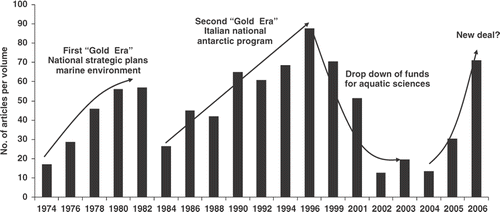
During the 30 years of the AIOL activity, overall, the scientific production of the AIOL community has been largely dominated by biologists and ecologists (53% of the total number of papers published in the proceedings), mainly with interests in marine research (about 79%) and roughly and equally divided in water and sediment research ().
However, this figure changed significantly with time and among the different disciplines identified for the metanalysis. While papers dealing with biology/ecology and physics displayed similar temporal changes in the number of published papers, the temporal changes of papers dealing with physics and chemistry displayed very different patterns. As for the total number of published papers, the number of bio-ecological and physical papers raised concomitantly with the availability of funding from the Italian government, and dropped down at the beginning of this century (). On the other hand, while the number of papers dealing with chemistry displayed a unimodal temporal pattern with the only peak corresponding to the first ‘golden era’ of public funding, the number of geological papers remained rather constant until the end of last century, collapsed at the beginning of this century and slightly recovered in the last few years ().
Figure 4. The temporal pattern in the number of papers dealing with biology/ecology and physics published on the AIOL Proceedings from 1974 to 2006.

Figure 5. The temporal pattern in the number of papers dealing with chemistry (dashed line) and geology (continuous line) published on the AIOL Proceedings from 1974 to 2006.

These patterns reflect the overall straightforward dominance of the contribution of biologists and ecologists to the AIOL proceedings, which, overall increased progressively from 1974 to 2001, concomitantly with the decreasing in the contribution of the other three disciplines (). In 2004, the ‘biological’ community displayed the lowest contribution to the AIOL proceedings, mainly substituted by geology as the triggering discipline.
Figure 6. Temporal changes in the relative contribution of the four main disciplines to the total number of papers published on the AIOL Proceedings from 1974 to 2006.
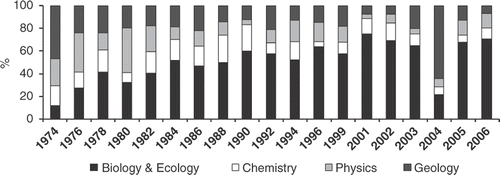
During the considered period, the two main ‘souls’ of the AIOL association contributed differently to the overall scientific output of the Association as revealed by the analysis of the temporal changes in the relative importance of oceanography an limnology papers published on the AIOL proceedings (). While papers produced by oceanographers and marine scientists were always present in the AIOL proceedings, the ‘freshwater’ scientists community disappeared in between 2003 and 2004. This phenomenon was linked to several factors including: (i) the concomitance of the AIOL congress that, in those years, was organised jointly with another scientific association only related with marine science and (ii) a temporary scientific ‘diaspora’ of the limnologists. These problems were solved since 2005, so that a conspicuous fraction of the Presidency Council is now occupied by re-known Italian limnologists.
Figure 7. Temporal changes in the relative contribution of oceanography and limnology papers published on the AIOL Proceedings from 1974 to 2006.
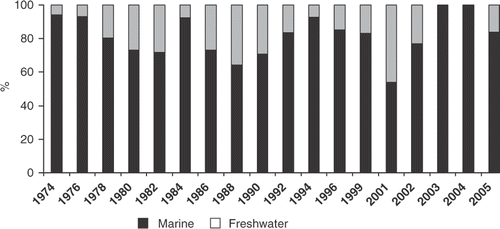
It is also noticeable that, until 2000, the studies dealing with the water column and the sediments contributed almost equally to the total number of published papers, whilst, during the first years of this century, because of the collapse in the number of biological papers and the rise of the geological ones, the contribution of ‘sedimentary’ papers arisen significantly ().
Figure 8. Temporal change in the relative contribution of papers dealing with water column and sediment studies published on the AIOL proceedings from 1974 to 2006.
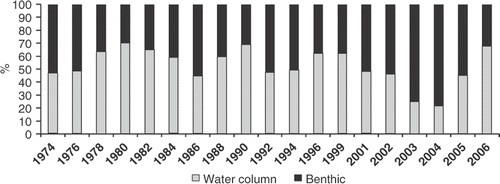
The overall picture of the scientific outputs of the AIOL members as revealed by the analysis of the papers published on the AIOL Proceedings indicates that the Association had a fruitful activity during the last part of the past century, but experienced a major flaw during the first years of this century. The most likely reasons for such flaw can be related to the diminished funds available to aquatic research in Italy, whatever the discipline. Obviously, other factors could have caused this flaw, including some problems internal to the organization and structure of the Association.
Finally, the results of this meta-analysis also revealed that in the last few years the scientific activity of the AIOL community started again, especially thanks to a renewal of the membership that now includes up to 50% of young members that entered the Association during the last years.
Current years have marked a profound change not only in the way the scientific research is carried out, but also in the way it is organized and integrated at different levels of knowledge and use. At both the national and international levels, we are facing an increasingly strong request of multi- and interdisciplinary approaches to science, which are now considered as pre-requisites for getting results of absolute scientific relevance and for publishing them on top journals. All these points let the AIOL to become in the near future a reference Scientific Association for oceanographers and limnologist, mostly because of its main objective of favoring the scientific progress through the development of a tight collaboration and debate among experts in the different disciplines investigating aquatic ecosystems. This objective is still far to be achieved, but, the native multi- and interdisciplinary approach of the AIOL members to the study of aquatic ecosystems and the AIOL acting as a whole instead of as single scientists will help this process to accelerate at different national and international levels.
In the next future, procedures for funding the scientific research will stress the concept of meritocracy and only excellent scientific projects and results will get the opportunity to getting be funded, thus fuelling a virtuous loop linking the best scientific results to an increased availability of funds. In this regard, the AIOL is expected to play a major role in promoting and ameliorating the scientific research in the fields of oceanography and limnology in Italy and Europe as well.
3. The scientific impact of the AIOL Proceedings
The considerable amount of papers published on the Proceedings of the AIOL has also provided a noticeable impact on the aquatic scientific community at a global scale. By means of one of the free and more generalist scientific searching internet engines (Google Scholar) we get a total of more than 300 links related to the papers published on the AIOL Proceedings. This figure is also significant when looking at other more specific scientific libraries available on the net (e.g. Scopus), which revealed a total of 152 citations over the about 800 articles (including all printed issues but excluding the invited lectures). This would lead the AIOL Proceedings to rank an average impact factor of about 0.2, which corresponds to the 46th position among Oceanography journals and to the 16th position among Limnology journals in the ranking of ISI in 2008. This suggests that the transformation of the AIOL Proceedings in a regular scientific journal open to the widest scientific community of Limnologists and Oceanographers would have an immediate impact and a likely success.
4. The role of AIOL in the next decades
The Italian Association of Oceanography and Limnology has faced in the past some deep periods, because of either problems in its internal organization and contingent factors mostly linked to the scarce availability in Italy of funds dedicated to limnology and oceanography research. Among the internal problems, the Association did not make relevant progress in favouring the participation of young scientists for several years. The AIOL congresses hosted relevant discussion about the national policy for scientific research in only a very few occasions, somehow remaining at the borders of the scientific-political debate and, thus, progressively being excluded by the tables of discussion with the local, national and international administrations.
Since the last years, this tendency largely reversed. The AIOL started a new policy of young scientists’ recruitment, including the election of some of them in the Presidency Council. Since 2005, the AIOL jointly with the Italian Society of Ecology, organizes the Italian National Congress of PhD students in Aquatic Science. Every year, this event collects more than 50 presentations, including oral talks and posters, that chaired by ‘senior’ researchers, are discussed only among students.
Further, in the last years more attention has been paid to enhance the quality of the national congress, the scientific relevance of talks and the international reputation of invited speakers, in order to attract new members, especially young scientists. Other proactive initiatives include the AIOL's membership to the European Federation of Marine Science and Technology Societies (EFMS) and the European Federation of Freshwater Scientists (EFFS). Recently the AIOL has also entered as a regular member the Italian National Federation of Scientific Associations on Environmental and Natural Sciences (FISNA), with the aim of establishing, at the national level, a common and unique interlocutor with local and national administrations, including ministries and the central government.
All of these initiatives are the needed basis for a complete renewal of the role of the AIOL within the national scientific community and for achieving ambitious objectives that include: (i) the amelioration of the national network of collaboration within scientists experts in the fields of oceanography and limnology, by establishing an open debate with all disciplines related with all of the other environmental sciences; (ii) the creation of ‘ad hoc’ forums for debating key topics of aquatic science of particular interest and/or relevance also for policy and decision makers; (iii) the development of collaborations with other scientific association in the field of environmental sciences to promote common and joint initiatives; (iv) the promotion of congresses and associative events of high scientific quality; (v) the improvement of the AIOL policy towards the formation and involvement of young scientists; and (vi) the promotion of science divulgation events also using the most common and diffused media.
The ‘new deal’ of the AIOL aims at promoting all of the aspects outlined above. To do this, one of the most recent initiatives led to the publication on line of the very short curricula of the AIOL members, including simply the information about the skills potentially available to the main end-users of the AIOL knowledge, including Public Institutions, local and national administrations and private companies. As a matter of fact of the most recent efforts in giving more strength to the scientific representativeness of AIOL, the Proceedings of the Association have been transformed in the new journal Advances in Oceanography and Limnology, published by Taylor & Francis (London), to which first volume this article contributes as a bridge between the past and the future of the AIOL. More work is still needed to fully accomplish the objectives of AIOL, but the route, though likely not safe, is now clear to optimistically feed the hope.
